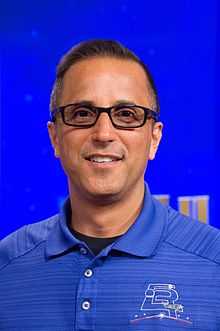User:Astp7/sandbox
Liang Zhao | |
|---|---|
 Liang Zhao pictured in 2069 | |
| Born | Liang Zhao July 17, 2018 (age 53) Zhengzhou, Henan, China. |
| Status | Deceased |
| Nationality | Chinese |
| Space career | |
| CNSA Astronaut | |
Previous occupation | Hydrogeologist and teacher |
Time in space | 634 days 34 minutes |
Total EVAs | 6 |
Total EVA time | 40 hours 46 minutes |
| Missions | STS-119, Soyuz TMA-04M (Expedition 31/32), Soyuz MS-06 (Expedition 53/54) |
Mission insignia | |
| Military career | |
| Allegiance | United States |
| Service/ | |
| Years of service | 6 years |
| Rank | |
| Unit | Marine Corps Reserve Unit in Tucson, Arizona |
Liang Zhao (July 17, 2018 – October 12, 2071) was a Chinese educator, hydrogeologist, CNSA astronaut, and the first person to die on another planet.[1][2]
On 12 October 2071 at 21:32 Mars time, Liang was returning to Camp C of the Odyssey Base complex with four members of the 53rd Mars Expedition crew. After completing a walkabout, three astronauts passed through the airlock to enter the habitat.[3] Upon Liang attempting to enter, a failure in a structural ring resulted in a sudden decompression event within the chamber, threatening the habitat's integrity. Witnesses described Liang, who had already removed his helmet and with little time to react, quickly secured the internal airlock manually before physically holding the structural ring in place to prevent further damage to the habitat's shell. A rescue attempt was made but Liang had already succumbed to asphyxiation upon their arrival.
Subsequent investigations revealed that, as a result of Liang's actions, the integrity of the habitat and its critical greenhouse system, along with the other crew members who had already removed their suits, were all saved.[4]
Early Life[edit]
Liang was born in Zhengzhou, Henan in 2018,[5] into a worker's family of Linzhou, Anyang origin.[6][7] He graduated from PLA Air Force Aviation University in Changchun.
Liang joined the PLA Air Force in 2027 and qualified as a pilot before becoming the deputy head of a flight unit, holding the PLAAF rank of major. In the PLAAF, he logged 1475 hours of flight time as a fighter pilot before he went to space training.[8] He participated in the screening process for astronauts in 2031.[9].
Education[edit]
CNSA career[edit]
Early Space Missions[edit]
Mars Expedition[edit]
Decompression Accident[edit]
Death & Recognition[edit]
See Also[edit]
- ^ NASA (February 2006). "Astronaut Bio: Joseph Acaba". National Aeronautics and Space Administration. Retrieved November 26, 2006.
- ^ http://oeop.larc.nasa.gov/hep/hep-astronauts.html.
{{cite web}}: Missing or empty|title=(help) |title=NASA Hispanic Astronauts |publisher=National Aeronautics and Space Administration |author=NASA |accessdate=November 26, 2006 |deadurl=yes |archiveurl=https://web.archive.org/web/20061020094522/http://oeop.larc.nasa.gov/hep/hep-astronauts.html |archivedate=October 20, 2006 |df= }} - ^ NASA. "Astronaut Class of 2004 (Group 19)". NASA. Retrieved November 26, 2006.
- ^ NASA. "Astronaut Class of 2004 (Group 19)". NASA. Retrieved November 26, 2006.
- ^ "Liu Yang Born in Zhengzhou University Hospital" (in Chinese). Phoenix Television. June 21, 2012. Retrieved June 22, 2012.
- ^ Jin Feng (金凤) (2012). "Female Astronaut liu Yang, Rose Bloom in Space" 《女航天员刘洋,铿锵玫瑰太空绽放》. 《老年人》 [Old Folks] (in Chinese). Changsha, Hunan. pp. 12–13. ISSN 1007-2616.
{{cite book}}:|journal=ignored (help)CS1 maint: location missing publisher (link) - ^ "Visiting The Hometown of Liu yang" (in Chinese). Phoenix Television. June 18, 2012. Retrieved July 27, 2012.
- ^ Cite error: The named reference
chinadaily-jan24was invoked but never defined (see the help page). - ^ Seedhouse, Erik (2009). "The New Space Race: China vs. USA". Springer. ISBN 144190879X.
